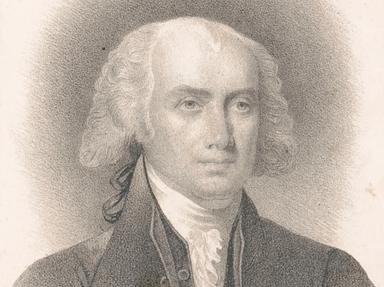Quiz Answer Key and Fun Facts
1. Although childless himself, James Madison is often called the "Father" of the United States Constitution, and the "Father" of which other bulwark of United States legislation?
2. The Bill of Rights: in 1789 James Madison presented Congress with 12 articles to amend the Constitution. Congress approved all 12 articles and sent them to the state legislatures for ratification. From 1789-1791, the states ratified 10 amendments to the Constitution (the articles numbered 3-12) as The Bill of Rights.
After more than 200 years, the states also ratified article #2. It became the 27th Amendment to the Constitution in 1992. Which is the subject of the 27th Amendment?
3. During 1787-1788 James Madison, Alexander Hamilton and John Jay authored a series of 85 essays advocating ratification of the proposed United States Constitution. Written under the pseudonym "Publius", these essays are known as which?
4. Before the War of 1812, the crème de la crème of social invitations was a "request of your presence" from President and Mrs. James Madison at a "levee" at the White House. Which term most closely describes a "levee" hosted by Dolley Madison?
5. President James Madison's unilateral proclamation of October 27 1810 annexed which lone-star republic to the United States as part of the Louisiana Territory?
6. James Madison's unfortunate and unnecessary war (The War of 1812) nonetheless produced "The Star-Spangled Banner" - the national anthem of the United States, written by Francis Scott Key in 1814. Given the history of the US flag, which elements of design were unique to the flag that was "gallantly streaming" o'er the ramparts of Ft. McHenry?
7. As soon as the War of 1812 began, which international leader offered to negotiate a peace treaty between the United States and Great Britain? His intervention was unsuccessful, and the war did not end until 1815, with the Treaty of Ghent.
8. A brief 1865 memoir by Paul Jennings, former slave of President James Madison, provides evidence that Dolley Madison did not, in fact, rescue the Gilbert Stuart portrait of George Washington from the burning White House in 1814. Parenthetically, who freed Paul Jennings from slavery on March 19, 1847?
9. After British troops burned the unfinished US capitol building in 1814, at which site did Congress meet from 1814-1819? Further, which modern building now occupies this site?
10. President James Madison was a prolific public speaker - soft-spoken and self-conscious of his high, thin voice. Curiously, which were his last spoken words before death in 1836?
Source: Author
socalmiguel
This quiz was reviewed by FunTrivia editor
gtho4 before going online.
Any errors found in FunTrivia content are routinely corrected through our feedback system.
